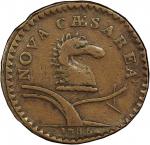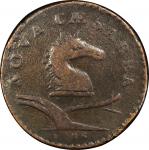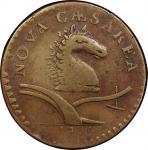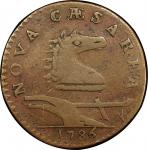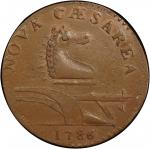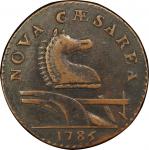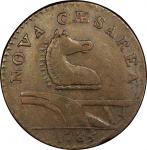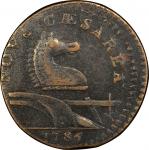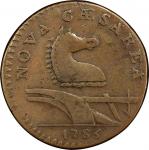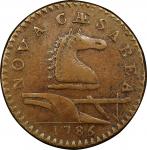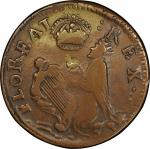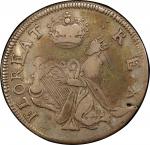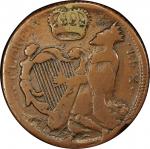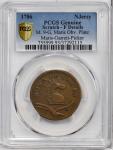1786 New Jersey copper. Maris 9-G. Rarity-7. No Coulter. Fine, Scratch (PCGS).148.7 grains. An especially historic specimen, the discovery specimen of the variety. Both of these dies were new to Maris when he located this coin sometime before 1875, at which time it appeared on his Woodburytype plate supplement to Crosbys <em>Early Coins of America</em>. Six years later, this piece was plated in Maris <em>The Coins of New Jersey</em> and described in the text as "Appears to be unique. Owned by the writer, who obtained it in the city of Wilmington, Delaware." Today, it is one of seven known, not the finest, but unquestionably the most historic. The surfaces are glossy and smooth light brown with deeper olive undertones and some golden highlights on the reverse. The obverse is aligned to 6:00, with the date at the edge and no denticles visible. The reverse is nearly ideally centered, showing just the merest trace of the die edge at the lower left. The defining flaws are three old scratches on the shield of similar length; some shorter scratches around them are very minor. A light lamination descends from the singletree across the plow to 86 of the date; this characteristic, along with the single tiny pit above C of CAESAREA are easily seen on the Maris plate and the Woodburytype Crosby supplement.<p>The die rotation matches the Boyd-Ford coin, showing the reverse about 35 degrees clockwise of medal turn. The central shield is pretty soft, and the E of E PLURIBUS UNUM is on its way out, with the top serif present but weak, making this Die State 2.<p>There are six of these in collector hands, assuming the New Jersey Historical Society specimen stays there. Three are considered finer than this one by Siboni, Howes, and Ish: the Taylor-Anton coin, the Martin coin that the late great Steve Tanenbaum found at a flea market, and the Demling coin with a long provenance that includes Spiro and ODonnell. Those that trail this one are the rough and worn Boyd-Ford coin that Partrick bought, the NJHS piece, and George Lymans well worn eBay find.<p>It may mean more to modern New Jersey copper collectors that this piece was depicted on Maris famous "elephant folio" plate for <em>The Coins of New Jersey</em> in 1881, but arguably the history surrounding this pieces inclusion on Maris 1875 Woodburytype plate is even more interesting. The Woodburytype plate published by Maris was intended as a supplement to Sylvester Crosbys <em>The Early Coins of America</em>, but not a particularly friendly one. When he helped reprint the plate in 1996, Charles Davis wrote an accompanying article that revealed Maris sense of rivalry with Crosby, his feelings that state coppers from places other than New England had been given short shrift, and his sharp desire to be recognized as a numismatic expert on Crosbys level. Maris first two works on the United States cents of 1794, published just a year apart in 1869 and 1870, received more criticism than acclaim, embittering the Quaker doctor from Philadelphia. His New England rival Crosby, in the meantime, was lavished with laurels for his 1873 series that became his 1875 magnum opus. Maris wrote a critique in the October 1875 issue of the <em>American Journal of Numismatics</em> that Davis described as "a bitter review, one dripping with sour grapes." Some of the sour grapes came from the reception of Maris work on 1794 cents compared to the round huzzahs given to Crosbys (better) work on the 1793s. Davis suggests some also came from Maris unknowing purchase of what we today call a "Whatsit," a 1787-dated Head Left New Jersey that had been reengraved from a Maris 63-q. When Crosby ruined Maris day by telling him exactly what he had, bad feelings turned from simmer to boil. And the Woodburytype plate appears to have been the dish served thereafter.<p>Maris sold his Woodburytype (the name for the photographic printing process used) plate for fifty cents. It depicted 48 coins in eight rows of six. These were intended to show 29 different varieties, though the publisher screwed up and ended up creating two varieties that dont exist: 1787 Connecticut Miller 6-L and 1787 Connecticut 4-M. Seven of the varieties were Connecticuts, three individual sides of Vermont coppers were shown (Ryder 13s obverse and both sides of Ryder 18), and the rest were New Jerseys: the obverses of Maris 9, 21, 26, 44, 52, 55, and 74, along with both sides of Maris 14-J, 24-P, 31-L, 38-Z, 40-b, 53-j, 56-n, 62-q, 63-q, 64-t, and 67-v.<p>The Woodburytype plate was Maris first published work on the New Jersey series, an effort that would be followed six years later with the relatively taut effort that would remain standard for the near century and a half since. This coins rarity will speak to every collector, but its history should transcend that and appeal even more to the dedicated enthusiasts of the New Jersey series.From the E Pluribus Unum Collection of New Jersey Coppers. Earlier, discovered by Dr. Edward Maris before 1875 in Wilmington, Delaware; Dr. Edward Maris Collection; H.P. Smith’s sale of the Dr. Edward Maris Collection, June 1886, lot 359; T. Harrison Garrett Collection; Johns Hopkins University to Richard Picker Collection; Stack’s sale of the Richard Picker Collection, October 1984, lot 182; William Anton Collection; E Pluribus Unum Collection, via Larry Stack.

